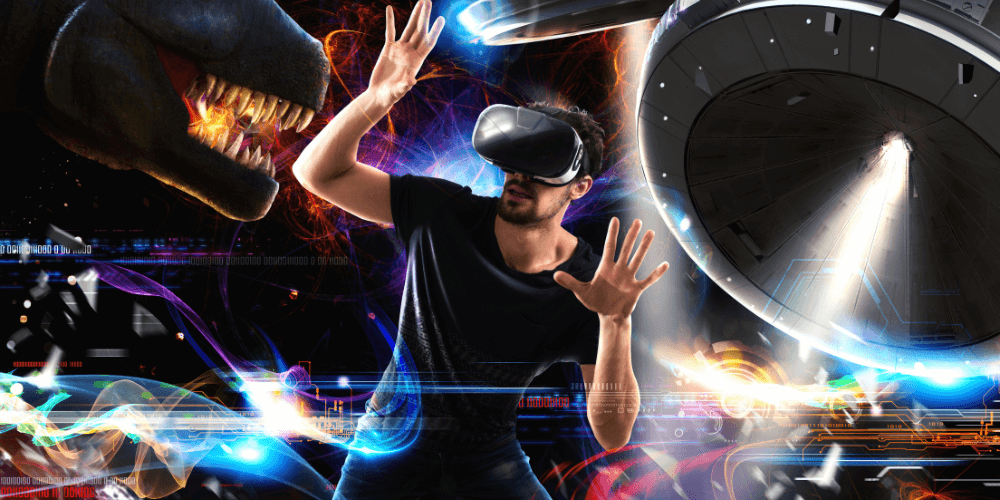Will the metaverse reshape our future?
The metaverse is a term coined by Neal Stephenson in his novel Snow Crash for a virtual reality-based multiverse where users can interact with each other and create their own content. It is a 3D world that can be accessed by anyone with an internet connection and a VR headset. The metaverse is also home to many businesses and organizations that have created their own virtual spaces for employees to interact with each other and customers. The metaverse is seen as the next step in the evolution of the internet and has the potential to change the way we live, work, and play.

According to the Securities and Exchange Commission, the term “metaverse” appeared in regulatory filings more than 1,100 times in the first six months of 2022. There were 260 mentions the previous year. What about the previous two decades? There were only a few dozen in total. Every corporate executive seems to feel the need to mention the metaverse—and, of course, how it naturally fits their company’s capabilities better than those of their competitors. Few seem to know what it is or what they intend to build. The executive class also appears to disagree on fundamental aspects of this new platform, such as the importance of virtual reality headsets, blockchains, and cryptocurrency, as well as whether it is here now, coming soon, or decades away.
None of this has a limited investment. Much has been written about Facebook’s rebranding as “Meta,” as well as the more than $10 billion it now loses each year on its metaverse initiatives. (Moore, 2022) However, six of the world’s largest public companies—Amazon, Apple, Google, Microsoft, Nvidia, and Tencent—have also been hard at work preparing for the metaverse. They are reorganising internally, rewriting job descriptions, rebuilding product offerings, and preparing multibillion-dollar product launches. McKinsey & Company estimates that corporations, private equity firms, and venture capitalists made $120 billion in metaverse-related investments during the first five months of this year. (Elmasry et al., 2022).
Almost all the work has thus far gone unnoticed by the public, like the metaverse itself. There is no such thing as a metaverse product, nor can “metaverse revenue” be found on an income statement. Indeed, it may appear that the metaverse, to the extent that it ever existed, has already come, and gone. Crypto has collapsed. So has Facebook’s market capitalisation, which peaked at $900 billion when the company changed its name to Meta before falling to around $445 billion today. This year, video game sales have dropped by nearly 10%, owing in part to the end of the pandemic that drove many people indoors. (Piscatella, 2022)

Many people think it’s a good thing that the metaverse is sputtering. The largest tech platforms have already established enormous influence over our lives, as well as the modern economy’s technologies and business models. It’s also clear that today’s internet has many flaws; why not address them before moving on to what Mark Zuckerberg refers to as “the successor”?
Every few decades, a platform shift occurs, such as the transition from mainframes to PCs and the internet, and then to mobile and cloud computing. Once a new era has begun, it is extremely difficult to change who leads it and how. However, those very things change between eras. If we want to create a better future, we must be as aggressive in shaping it as those who are investing in it.
So, what exactly is this future? Consider the metaverse to be a parallel virtual plane of existence that spans all digital technologies and will eventually control a large portion of the physical world. This concept helps to explain another popular description of the metaverse as a 3D internet—and why establishing it is both difficult and likely to be worthwhile.
Today’s internet spans nearly every country, 40,000 networks, millions of applications, over a hundred million servers, nearly 2 billion websites, and tens of billions of devices. (Heusser, 2021) Each of these technologies can exchange information coherently and consistently, find one another “on the net,” share online account systems and files (a JPEG, an MP4, a paragraph of text), and even interconnect (consider how a news publisher links to another outlet’s report). Nearly 20% of the global economy is considered “digital,” with the remaining 80% relying heavily on it.
Though the Internet is resilient, broad, and powerful, it was not designed for live and interactive experiences involving many participants, particularly when it comes to 3D imaging. Rather, the internet was designed primarily so that a single static file (such as an email or spreadsheet) could be copied and sent from one device to another, allowing it to be reviewed or modified independently and asynchronously. This is one of the reasons why, even in the age of “Streaming Wars” and multibillion-dollar tech companies, simple two-person video calls can be so unreliable. It is a wonder that online multiplayer games work at all. There’s also no agreement on file formats or conventions for 3D information, and no standard systems for exchanging data in virtual worlds. We also lack the computational power to realise the metaverse as we envision it. Not only will we need VR goggles, but also holographic displays, ultrasonic force-field generators, and, as strange as it sounds, devices to capture electrical signals sent across muscles.

We cannot predict how important a 3D internet will be to our global economy, just as we did not predict the value of the internet. But we do have an opinion on the matter. We have progressed from colourless text to primitive webpages and web blogs, then to online profiles (like a Facebook page), video-based social networks, emojis, and filters as internet connectivity and computer processors have improved.
We have gone from a few messages, board posts, emails, or blog updates per week to a constant stream of multimedia content encapsulating our lives. The next step in this trend appears to be a persistent and “living” virtual world that is not just a window into our lives or a place where we communicate about them, but one in which we also exist—and in 3D.

We have long anticipated that the digital era would transform education, but it has so far resisted. Since 1983, the cost of higher education has increased by more than 1,200%; medical care and services, which ranks second in cost increases in the United States during that time, have increased by half as much. The difficulty is that the real thing requires no fewer resources than it did decades ago, and what is lost when switching to a remote computer screen. Making direct eye contact, experimenting with your hands, the equipment, Zoom school, YouTube videos, and digital multiple choices do not replace the real thing.
In 2021, Johns Hopkins neurosurgeons used an augmented-reality headset to perform the hospital’s first-ever live patient surgery, providing the surgeon with an interactive display of the patient’s internal anatomy (John Hopkins, 2021). Dr. Timothy Witham, who performed the surgery and is also the director of the hospital’s Spinal Fusion Laboratory, compared it to having GPS. This frame of reference is critical. We frequently imagine the metaverse replacing the technology we have now such as using a VR headset to watch TV, drive, and work.
Google unveiled its Project Starline device earlier in 2021, which uses machine learning, computer vision, a dozen depth sensors and cameras, and fabric-based multi-layered light field displays to create 3D “holographic video” without the use of mixed reality goggles. Google claims that its Starline technology leads to 15% more eye contact, 25-50% more nonverbal forms of communication (hand gestures, head nods, brow movements), and 30% better memory recall of the conversation when compared to traditional “2D” video calling. Few of us enjoy Zoom; perhaps adding another dimension will alleviate some of our annoyance.

However, for society, it is unclear what the metaverse entails. Some are understandably concerned, seeing billions of dollars invested in what appears to be a game. Consider the metaverse to be a fourth computing and networking era, succeeding mainframes from the 1950s to the 1970s, personal computers and the Internet from the 1980s to the mid-2000s, and the mobile and cloud era we are experiencing today. Each epoch altered who had access to computing and networking resources, as well as when, where, why, and how. These changes had far-reaching consequences. They were, however, difficult to predict precisely.
Even the most ardent supporters of the mobile internet struggled to predict more than “more people are online more often, for more reasons”. Having a detailed technical understanding of digital networking, or deploying billions in R&D, did not illuminate the future. In this regard, we must acknowledge that confusion, conflation, and uncertainty are necessary conditions for disruption.
However, there are specific issues that can be resolved. The metaverse is frequently misrepresented as immersive virtual reality headsets like the Meta Quest (née Oculus VR) or augmented reality glasses like Google’s infamous Glass. Virtual Reality (VR) and Artificial Reality (AR) devices may become popular ways to access the metaverse, but they are not the only ones. Considering that smartphones are not the same as mobile internet, the metaverse is also not the same as Roblox, Minecraft, Fortnite, or any other game; these are virtual worlds or platforms that are likely to be part of the metaverse, just as Facebook and Google are. For similar reasons, consider the metaverse to be singular, just as we say, “the internet” rather than “an internet”. To the extent that different internets exist today, this is largely due to regional regulatory differences. Another common conflation is between the metaverse and Web3, crypto, and blockchains. This trio may play an important role in realising the potential of the metaverse, but they are merely principles and technologies. Indeed, many metaverse leaders are sceptical of crypto’s future.

The metaverse should not be viewed as a replacement for the Internet or for all mobile models, devices, or software. It will give rise to new technologies and behaviours, but that does not mean we abandon our preferences. We still write on a PC, and it is likely that will continue to be the best way to write long-form text. Even though most of the internet traffic today originates and terminates on mobile devices, nearly all of it is transmitted via fixed-line cables and the Internet Protocol Suite as it was designed in the 1980s.
The metaverse has not yet arrived even if some executives will claim it has or is at least imminent. At the same time, transformations do not have “switch flips”. We live in the mobile era, but the first cellular network call was in 1973, the first wireless data network in 1991, the first smartphone in 1992, and so on until the iPhone in 2007. While it is impossible to say when the metaverse began, it is undeniably in progress. Tim Sweeney, CEO and founder of Fortnite maker Epic Games, tweeted pre-release code from the company’s 1998 game Unreal in mid-2021, adding that players “could go into portals and travel among [different worlds] …with no combat and [would stand] in a circle chatting.” (Ball, 2022) These experiences did not take off at the time for a variety of reasons—there were too few people online, and tools for world-creation were too difficult.
The metaverse is not necessarily dystopic. This is a common misconception because the term “Metaverse” comes from Neal Stephenson’s dystopian novel Snow Crash, the forefathers leave readers with the impression that the metaverse exacerbated the real world. Most fiction is based on drama; utopias are rarely the setting for popular stories. However, numerous “proto-metaverses” have emerged since the 1970s that are focused on collaboration and creativity rather than subjugation or profiteering. The realism of these worlds improves with each decade, as do their functionality, value, and cultural impact.

Over several decades, the foundation of today’s internet was built by government research labs, universities, and independent technologists and institutions. These mostly non-profit collectives typically focused on establishing open standards that would allow them to share information from one server to another, making future technologies, projects, and ideas easier to collaborate on. The advantages of this approach were numerous. Anyone, from any device, on any network, could access or build on the internet for little or no cost.
None of this prevented businesses from profiting from the internet or from creating closed experiences through paywalls or proprietary technology. Rather, the internet’s “openness” enabled more companies to be built, reaching more users and making more profits while preventing pre-internet titans from controlling it. Because of this openness, the Internet is regarded as having democratised information, and most of the world’s most valuable public companies were founded or reborn during the internet era.
It is easy to imagine how different the internet would be if it had been created by multinational media conglomerates with the intention of selling widgets, serving ads, or harvesting user data for profit.
However, the current expectation for the metaverse is a “corporate internet.” When the internet was born, government labs and universities were the only institutions with the computational talent, resources, and ambitions to create a “network of networks”, and few in the for-profit sector anticipated its commercial potential. When it comes to the metaverse, none of this is true. Instead, private companies are pioneering and building it.
Long before the metaverse was seriously considered by corporate executives worldwide, Epic Games’ Sweeney told VentureBeat in 2016 that “if one central company gains control of [the metaverse], they will become more powerful than any government and be a god on Earth.” Such a claim is easily dismissed as exaggerated. However, Citibank and KPMG estimate that the metaverse could generate up to $13 trillion in revenue per year by 2030. Morgan Stanley estimates $8 trillion in both the United States and China, which is like Goldman Sachs’ global forecast of between $2.5 and $12.5 trillion; McKinsey predicts $5 trillion globally. Jensen Huang, the founder, and CEO of Nvidia, which was one of the top ten publicly traded companies in the world for much of the year, believes the GDP of the metaverse will eventually surpass that of “the physical world.”

In this context, fears of dystopia appear reasonable rather than alarmist. The concept of the metaverse implies that an increasing portion of our lives, labour, leisure, time, wealth, happiness, and relationships will be spent inside virtual worlds rather than simply aided by digital devices. It will be a parallel plane of existence that sits atop and connects our digital and physical economies. As a result, the companies that control these virtual worlds and their virtual atoms will be more dominant than those that control the digital economy today.
Many of today’s difficult digital problems, such as data rights, data security, misinformation and radicalisation, platform power, and user happiness, will become more acute because of the metaverse. The philosophies, cultures, and priorities of the companies that lead in the metaverse era, rather than simply being more virtual or remunerative, will thus help determine whether the future is better or worse than our current moment.
As the world’s largest corporations and most ambitious start-ups pursue the metaverse, we—users, developers, consumers, and voters—must understand that we still have agency over our future and the ability to change the status quo, but only if we act now. Yes, the metaverse can appear intimidating, if not downright frightening, but this moment of transition is our opportunity to bring people together, transform industries that have resisted disruption, and build a more equal global economy.
Much of the future is uncertain, as was the internet in the 1990s and 2000s. But we can understand how and why the metaverse will work; which experiences will be available when, why, and to whom; and what will go wrong and what must go right. And, like Big Tech, we can use this information to shape the future. As executives are fond of reminding us, trillions of dollars are at stake—and, more importantly, our lives.



















